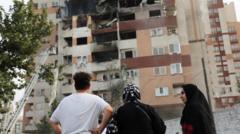Experts highlight the evolving nature of combat as drone strikes reshape the landscape of modern warfare.
### Drones Redefine Warfare Tactics in Israel-Iran Conflict

### Drones Redefine Warfare Tactics in Israel-Iran Conflict
Increased use of advanced drones marks a significant shift in military strategies between adversaries.
In recent developments, the conflict between Israel and Iran has seen a notable escalation in the use of drones, marking a transformative shift in military tactics employed by both nations. As the effectiveness of drones increases, with their small size and stealth capabilities, their impact on warfare dynamics is growing, prompting nations to reevaluate their defensive strategies.
On June 14, 2025, reports indicated that Israeli forces successfully executed covert operations resulting in significant damage to Iranian military assets, including missiles and air defenses. This attack drew parallels to a previous incident in which Ukraine deployed 117 drones against Russian aircraft, highlighting the potential of drones to strike from within enemy territory. This emergent tactic not only complicates adverse responses but also forces enemies to guard against threats emanating from various vectors.
Retired Israeli brigadier general Assaf Orion pointed out that Israel's strategic advantage lay in its ability to launch attacks from unexpected angles, amplifying the surprise element in their operations. The behind-the-lines tactics, involving the meticulous planting of drones and other weaponry, underscore the intersection of espionage and cutting-edge technology in contemporary conflict scenarios.
The exact details surrounding these operations remain classified, as disclosing them could undermine intelligence-gathering methodologies. Nonetheless, the recent assaults signify a pivotal moment in the evolution of warfare, as nations adapt to counter not only the physical threats posed by drones but also the intricate strategies involved in deploying them.
As we move forward in this new era of warfare, the implications of such strategies are noteworthy, prompting military analysts to consider the future landscape of combat and defense against aerial incursions that arise from within enemy territories.
On June 14, 2025, reports indicated that Israeli forces successfully executed covert operations resulting in significant damage to Iranian military assets, including missiles and air defenses. This attack drew parallels to a previous incident in which Ukraine deployed 117 drones against Russian aircraft, highlighting the potential of drones to strike from within enemy territory. This emergent tactic not only complicates adverse responses but also forces enemies to guard against threats emanating from various vectors.
Retired Israeli brigadier general Assaf Orion pointed out that Israel's strategic advantage lay in its ability to launch attacks from unexpected angles, amplifying the surprise element in their operations. The behind-the-lines tactics, involving the meticulous planting of drones and other weaponry, underscore the intersection of espionage and cutting-edge technology in contemporary conflict scenarios.
The exact details surrounding these operations remain classified, as disclosing them could undermine intelligence-gathering methodologies. Nonetheless, the recent assaults signify a pivotal moment in the evolution of warfare, as nations adapt to counter not only the physical threats posed by drones but also the intricate strategies involved in deploying them.
As we move forward in this new era of warfare, the implications of such strategies are noteworthy, prompting military analysts to consider the future landscape of combat and defense against aerial incursions that arise from within enemy territories.





















